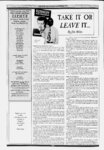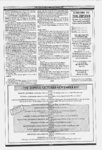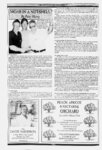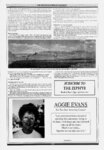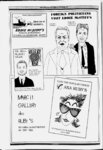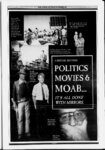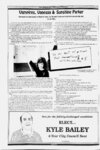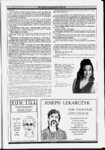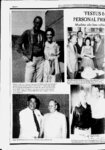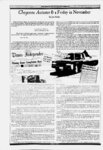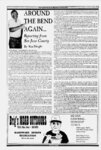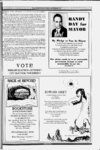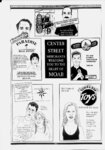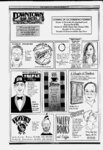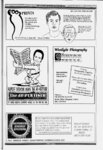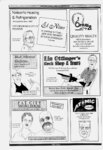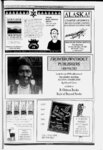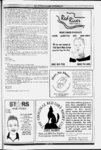| OCR Text |
Show AROUND THE BEND 5GAIN... Reporting from San Juan County Ken Sleight CALVIN BLACK - A REMEMBRANCE OF A FIGHTER Editorpublisher Jim Stiles asked me if I would supply a few of my reminiscences of Calvin Black. Raking up the past brings some cherished and not so cherished memories. It is not an easy chore to relate accurately the events or circumstances of the past as it takes some deeper thought. And thought can be prejudiced or colored. I remember that years ago Cal Black and I were once friendly associates. We had a number of similarities. We both were the same age, he but five months older. We both had conservative roots. We both were raised in a rural environment. We both had long enjoyed the use of federal lands. And we both had common genealogical lines and cultural heritage. We both became involved in the promotion of the tourist industry in Southern Utah. Along with canyoneer Frank Wright, Cal was an owner of the Lake Powell Ferry Service at Hall's Crossing providing trips on the new reservoir. I was a guide and outfitter working out of Escalante and providing horseback and boating trips in Glen and Escalante Canyons. I have been an open critic of Cal for a long time. However the fact remains that Cal Black contributed much to San Juan County. He was extremely dynamic and he was a ditch fighter. He fought for many seemingly lost causes. He won some, but still he continually expressed being victimized. He felt he had to step out and carry the defensive fight to the enemy. But in the same vein, as a fighter, he received much in return from San Juan County and the people in it. And through his actions he left a few negatives. These can be enumerated through the eyes of his own victims. It was not easy to oppose Cal in a public forum. I always felt some trepidation in our confrontations. He was a tough nut. He used his commissioner's office in San Juan County as his power base. From this base he expressed himself most eloquently. County tax dollars supported him in his quest. The dollars sent him into many quarters and to many functions in which to express his views. And through his actions, he was able to show all of rural Utah that county courthouses could indeed be used as centers for such movements as the now defunct "sagebrush "wise-us- e rebellion" and the present movement." He must have enjoyed the political fight. He made many friends and many enemies. I feel he often neglected his county administrator duties in his personal drive to fight the system. He had his opponents even in his own party. But his relentless drive kept him in office. He once ran for the State Senate but lost He was unable to attract many voters other than just the conservatives. His appealing nature would have carried him for had he nut on all fronts and at each turn. stamped himself as We talked of our own personal philosophies on a number of occasions. I remember well one conversation we had at his Elk Ridge Restaurant in B landing years ago. For an hour or so, we shared our own conservative feelings. I told him of my support of Barry Gold water for president, my admiration for Ezra Taft Benson, and my s college-day'toying with the John Birch Society. He asked me to support him in his political endeavors. He was convinced that things could be changed and that he could make it happen. However, even then, we differed in our approach to politics. I told him of my concerns - that indeed, conservatism need not mean the despoliation of land and resources. It meant conserving them. The words, "conservation" and "conservatism," both came from the same roots, I reasoned with him. so-call- ed ultra-conservati- ve We could have both. He rebutted that it was God's will that we use the resources for man's use. I reminded him of former President Teddy Roosevelt's natural resource policies, and then left him with the thought that we should not destroy the veiy thing people are coming to see and to enjoy. Shortly after Canyonlands National Park was created, the Sierra Club sponsored a retreat at Canyonlands. Many leading officials were invited. Among them who came were Cal Black, Robert Red ford, and other dignitaries. The informal event lasted for into the night. When most of us had climbed into our sleeping bags. Cal Black was still sitting at the picnic table espousing his views with anyone remaining that would listen. Cal liked to write as well as he liked to speak. He wrote numerous editorials and supporting his points of view while attacking other's views. In this, he to attracted attention himself. At times these editorials benefitted his causes, but they also brought on forces of heavy opposition. Cal Black was a dynamic and effective leader. He was able to enlist the leaders of rural Utah to his cause. And in so doing, he became their absolute leader. So effective was he, he had them eating out of his hand. He entrenched himself in councils that he could heavily influence. For instance, he gained positions on both the Utah BLM Advisory Board and the national BLM Advisory Board at the same time. Through this, he was able to gain national influence. He enjoyed hobnobbing with the likes of Secretary of Interior James Watt Both of these men were of the same political persuasion. One big difference between the two: Cal had an open door to the public; Watt didn't. Watt gave Cal some type of an award in 1983 for his many radical efforts and accomplishments. Cal Black was indeed effective in many of his efforts. He garnered many subsidizing projects for the rural white communities of the county. Far more money came in than went out He was supportive of new business growth in San Juan County. On a personal level, he was supportive of Jane and my endeavors to the purchase and development of Pack Creek Ranch. We had our agreements. I supported his efforts in seeking revenue from the federal untaxable lands that greatly surrounded private lands. In 1976, a new program was ." instituted that was called (PILT). Annually assessed, the PILT funds acts as a tax on federal property. Cal, along with many other westerners, fought hard for this. He involved himself in the promotion of the uranium industry. In this he succeeded admirably as long as there was a market for the mineral. He vigorously promoted the drilling of new oil fields. He was a fierce advocate for the mineral industry. These industries needed roads, many of them, and he ruthlessly developed roads fen1 them in virgin canyon wilderness areas where roads had never been. He energetically supported the proposed high level nuclear waste dump to be built near the border of Canyonlands National Park. In this, his efforts were thwarted on nearly every turn. Cal became a fierce opponent of wilderness designation of lands within the county. He feared wilderness designation would hamper development and lock up huge areas of land for the exclusive use of a few elitists. He spent long hours fighting the effects of the Wilderness Act and his efforts paid off. BLM pulled bade and foiled to designate many true pristine areas during the study phase. He joined with others throughout the West in supporting a "Sagebrush Rebellion" bill that would transfer millions of acres of western federal lands to focal control. letters-to-the-edit- or "payment-in-lieu-of-taxes- "tree-huggin- So as the years passed, g" our differences expanded; our conservative friendship diminished. In place of cooperation came many environmental fights. I became a bit more liberal in my thinking, and Cal became even more entrenched toward radical conservatism (Le. Sagebrush Rebellion). Cal's effectiveness continued. My friend Edward Abbey took note and accepted Cal's accomplishments as a personal challenge. Ed and I continually discussed and condemned Cal's many destructive proposals and actions, and we rightly feared his ambitions and influence. Ed used to call me and ask, "What damn thing is Cal Black up to now? And I'd give him a long recitation. Through it all, Cal seemed to be getting bigger than life. Abbey fought him at each turn. Abbey's new book. The Monkey Wrench Gang , stamped Abbey as Cal's leading antagonist Surely, Abbey's was the strong voice the environmental community needed to combat the voice of Cal Black. (Editor's note: In feet, Abbey fashioned toe character Bishop Love after Cal Black. And Seldom Seen Smith, of course, here a remarkable resemblance to the author of this story J It wasn't only in the environmental field that Cal had his growing problems. He was even less effective in his dealings with Native American peoples. The Indian peoples in the county were so politically discriminated against, the US. Justice Department ordered a new commissioner district be established to ensure Indian representation in the county. This brought on new problems to die white community. Marie Mary boy, the newly-electe- d young Navajo Indian commissioner, entered into a classic fight with Cal when he came on the scene. Mary boy was effectively able to bring the plight and discrimination of die Indians to light The eruption caused nation-wid- e WE HAVE EVERYTHING... FROM SOUP TO NUTS. 702 S. Main, Moat 250-573- 1 Dried soups, that is. And other freeze-drie- d camp foods. HARDWARE SPORTS RECREATION Steel Nuts, that is, not counting other nuts like our own Terry & Gary All In one store TWENTY-FOU- J |

